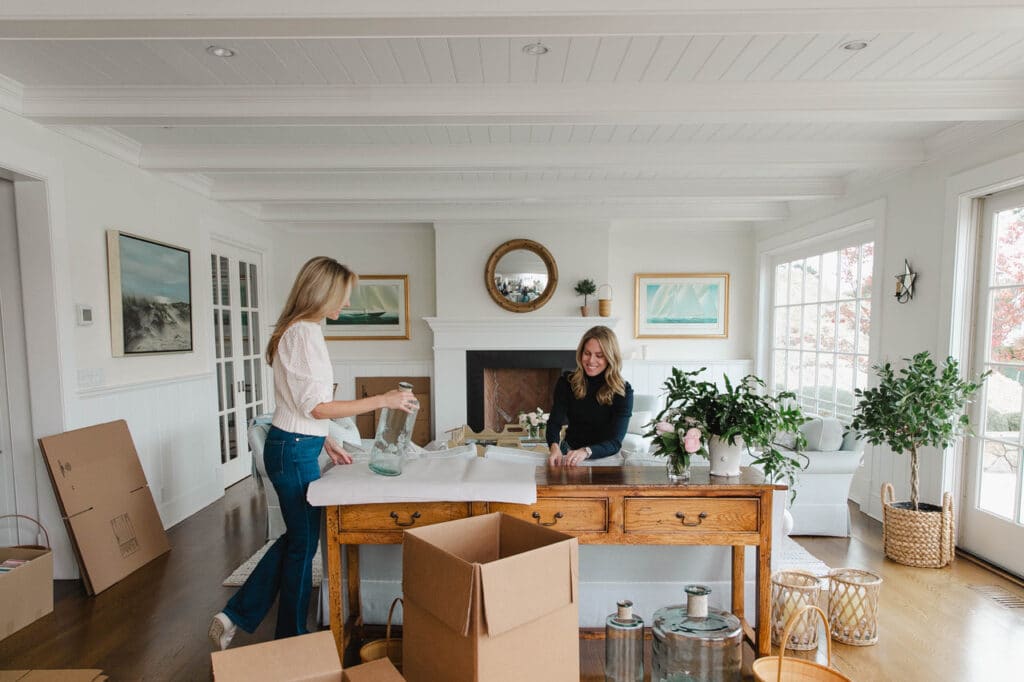A few weeks ago, I got so fed up with the space under my bathroom sink being in total disarray—so.many.products.—that I knew it was finally time to do something about it. So I set out on an organization mission: After throwing away a bunch of junk, I ultimately put back everything from face wash to travel size shampoos in a way that I hoped would make it easy to keep up with. We have managed to stay on top of it—I should say for the record that my husband is much more organized than I am—and I feel so accomplished.
The whole process (minus a bin-buying trip to Target) took only half an hour or so—and I wondered why it took me so long to actually get my act together. Why is it that we feel so overwhelmed when it comes to organizing—and what can actually help? To answer that, I turned to the duo behind The Settler, a company that focuses on both move management and professional organizing.
“There are two main reasons people feel overwhelmed by organizing,” explains Bridget Urgo, partner and head of organization services at The Settler. The first? “People have a sentimental and emotional attachment to many of the items in their home, such as family heirlooms that have been passed down, kid’s artwork, and then, of course, the clothes. The clothes closet is always one of the hardest spaces,” she says.
Adding to that is the feeling that you have to tackle everything in one sitting. “They think about their biggest pain points and feel intimidated and they can’t do it,” Urgo explains.
How to Beat The Overwhelm
To help, Urgo offers up a few ways to beat the overwhelm, so you can actually get started:
Focus on less emotional spaces. As she mentioned, spaces like closets and the kids’ art pile can be triggering, so instead, “begin with a space that has no emotional attachment,” she advises. One recommendation? Try the spice drawer. “Herbs and spices have expiration dates, and you know if you use it or not, and it can go straight in the trash,” she explains. “There’s no figuring out where it needs to go next.” And that leads to a larger lesson: “Success with a small space will lead to confidence for a larger one.” (She also recommends the bathroom, which is very gratifying to find out!)
Quick bursts of activity are best. “Set a timer for short intervals, like 15 or 30 minutes, to maintain focus and prevent burnout,” Urgo notes. “Taking regular breaks can make the process more enjoyable.” Equally important: Know what you’re getting into. “Do not start this if you have to be out of the door in 20 minutes or you have a work deadline. It will not end well and you’ll leave the house with more of a disaster,” says Urgo.
Mark your achievement. Take a page from my book and tell everyone—including, as evidenced here, the entire Internet—about your success. “We recommend you acknowledge and celebrate small victories along the way,” says Urgo. “Recognizing your achievements boosts motivation and makes the organizing process more rewarding.”

What Spaces to Organize
Once you feel less overwhelmed and have some smaller spaces under your belt, what are top areas of the home to tackle, especially in the throes of winter? A few suggestions:
The playroom.
“The holidays come with an influx of gifts, and kids items, in particular, are overflowing,” explains Urgo. In the playroom, she recommends instituting a ‘one in, one out’ rule: “Bring a toy in and take one out to donate or simply ready for the trash,” she says.
Your closet.
As for clothes, opt for that same rule, suggests Urgo—and don’t be afraid to cut down. “No matter how careful, everyone has duplicates,” she explains. “If you have five black sweaters, have you worn all those in the past year? Did you just get a new one? Pick just two or three and the rest you can give away.”
Pantries and medicine cabinets.
“In addition at this time of year, people are generally setting goals to get healthier, so it’s good timing to go through pantries and medicine cabinets to edit the items that you never use and may be unhealthy,” advises Urgo. Both she and Jackie Randall, partner and the head of moving services at The Settler, recommend various products to help in the process, like over-the-door racks, which can create more storage in places like the pantry.
The kitchen.
No matter how big (or small) your kitchen is, figuring out the best way to organize and set it up can be, well, alot. “The key with kitchens is to take what you have and categorize it into zones that make sense for the way you live and you function,” says Randall. She recommends deciding on the ideal zones for each item—prepping, cooking, baking, tabletop—and then organizing. “This streamlines workflow and reduces the chaos,” she says. Overall, she says, “The key is to give prime real estate to the contents you may use most and less priority to the contents you use least.” A few tricks of the trade she recommends:
- A pantry or closet snack station, which “makes it convenient for everyone to grab a quick snack without disrupting the cooking area.”
- Similar items stay together, like cutting boards or baking sheets. “This makes it easier to find what you need when you need them.”
- Everyday dishes and glassware near the sink, fridge, and dishwasher, “so they are easier to grab and put away,” she says.
- Throw out what you don’t need—including the plastic containers with no lids: “It’s unlikely you’ll have that top again!”



